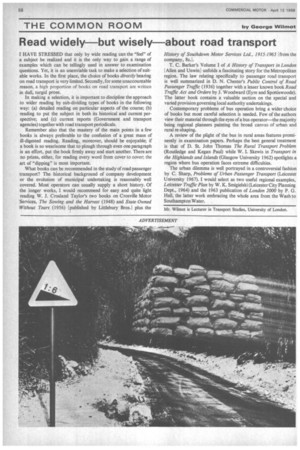THE COMMON ROOM by George Wilmot
Page 60

If you've noticed an error in this article please click here to report it so we can fix it.
Read widely but wisely about road transport
I HAVE STRESSED that only by wide reading can the "feel" of a subject be realized and it is the only way to gain a range of examples which can be tellingly used in answer to examination questions. Yet, it is an unenviable task to make a selection of suitable works. In the first place, the choice of books directly bearing on road transport is very limited. Secondly, for some unaccountable reason, a high proportion of books on road transport are written in dull, turgid prose.
In making a selection, it is important to discipline the approach to wider reading by sub-dividing types of books in the following way: (a) detailed reading on particular aspects of the course; (b) reading to put the subject in both its historical and current perspective; and (c) current reports (Government and transport agencies) together with road transport periodicals.
Remember also that the mastery of the main points in a few books is always preferable to the confusion of a great mass of ill-digested reading. Reading, moreover, should be enjoyable; if a book is so wearisome that to plough through even one paragraph is an effort, put the book firmly away and start another. There are no prizes, either, for reading every word from cover to cover; the art of "dipping" is most important.
What books can be recommended in the study of road passenger transport? The historical background of company development or the evolution of municipal undertaking is reasonably well covered. Most operators can usually supply a short history. Of the longer works, I would recommend for easy and quite light reading W. J. Crosland Taylor's two books on Crosville Motor Services, The Sowing and the Harvest (1948) and State Owned Without Tears (1956) [published by Littlebury Bros.] plus the History of Southdown Motor Services Ltd., 1915-1965 [from the company, 8s.l.
T. C. Barker's Volume I of A History of Transport in London [Alien and Unwin] unfolds a fascinating story for the Metropolitan region. The law relating specifically to passenger road transport is well summarized in D. N. Chester's Public Control of Road Passenger Traffic (1936) together with a lesser known book Road Traffic Act and Orders by J. Woodward (Eyre and Spottiswoode). The latter book contains a valuable section on the special and varied provision governing local authority undertakings.
Contemporary problems of bus operation bring a wider choice of books but most careful selection is needed. Few of the authors view their material through the eyes of a bus operator—the majority being regional planners painting the broad canvas of urban and rural re-shaping.
A review of the plight of the bus in rural areas features prominently in examination papers. Perhaps the best general treatment is that of D. St. John Thomas The Rural Transport Problem (Routledge and Kegan Paul) while W. I. Skewis in Transport in the Highlands and Islands (Glasgow University 1962) spotlights a region where bus operation faces extreme difficulties.
The urban dilemma is well portrayed in a controversial fashion by C. Sharp, Problems of Urban Passenger Transport (Leicester University 1967). I would select as two useful regional examples, Leicester Traffic Plan by W. K. Smigielski (Leicester City Planning Dept., 1964) and the 1963 publication of London 2000 by P. G. Hall, the latter work embracing the whole area from the Wash to Southampton Water.




































































































